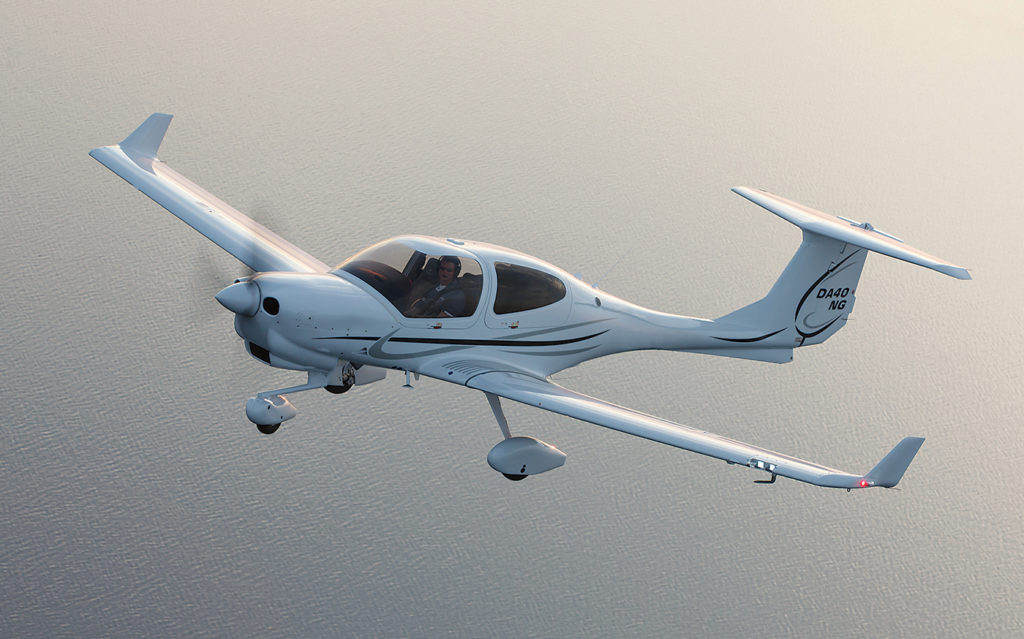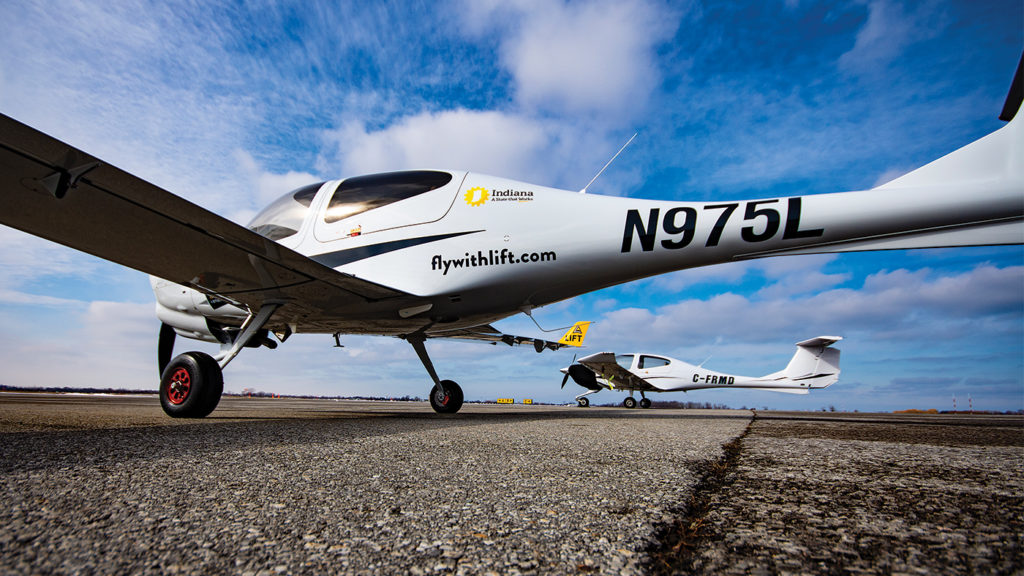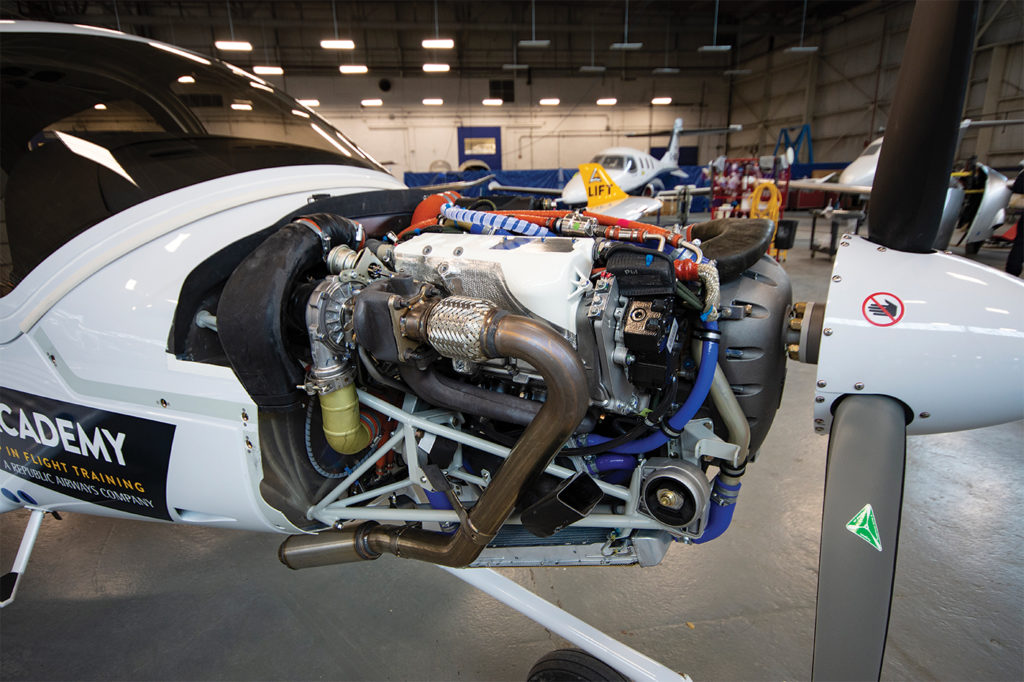Estimated reading time 12 minutes, 17 seconds.
The Diamond DA40 has been a favourite of owners and pilots since it was introduced in 1997. I first saw it in the early 2000s and remember being impressed by its striking design, highlighted by its seemingly impossible curves. In a sea of Cessna 172s, Piper PA28s and Beechcraft Musketeers, it looked like a spaceship in comparison.

In 2005, the DA40 was offered with Garmin’s G1000 avionics suite and for the first time the inside of the airplane was as revolutionary as its exterior. The Diamond DA40 NG (“Next Generation”) continues in this spirit of evolution and showcases what’s next for Diamond’s popular four-seater.
I have extensive experience flying the Lycoming-powered version of the DA40 all over North America and appreciate its comfort and efficiency. I have also flown the Diamond DA42 twin diesel-powered aircraft, which allowed me to experience the wonders of diesel power. My recent flight with Trevor Mustard, aircraft sales manager for Diamond Aircraft in London, Ont., was my first opportunity to fly the diesel-powered NG version of the DA40. It combines the airframe I am very familiar with and the innovative Austro AE 300 diesel engine. I was excited to see the changes that Diamond made when creating the NG.
The aircraft we flew for this article was destined for a large U.S. flight school that was undoubtedly attracted to the low fuel burn afforded by the extremely efficient diesel engine. The AE300 engine is rated at 168 horsepower, yet our test flight showed typical fuel burns of five to 5.5 gallons per hour – close to half the fuel burn of a conventional gasoline engine. Not only does it burn less fuel than its avgas-burning cousin, the diesel engine burns jet fuel – which is less expensive, available worldwide and is lead-free. A busy flight school could take advantage of those fuel savings and realize a payback in short order.
Although the diesel engine is the most obvious difference between the NG and the legacy DA40s, it is not the first thing one notices when walking up to the airplane. The first feature that caught my attention was its yellow winglets. Before the NG, DA40s were mostly white, apart from the registration markings and some decorative striping. Basically, you could get one in any colour you wanted – as long as it was white. Mustard explained that Diamond is developing improved resins that allow more of the airplane to be different colours with fewer limitations. It makes me wonder if some day we might see a candy apple red DA40? Time will tell.

The other external feature that stands out is the airplane’s stance on the ramp. The landing gear is obviously more substantial, and the tail of the airplane sits much higher than the older model. It looks like this landing gear can absorb whatever punishment even the most ham-fisted student pilot can inflict. The new gear was a necessity because the diesel engine is heavier, allowing Diamond to increase the maximum takeoff weight to 2,888 pounds (1,310 kilograms) up from 2,646 lb. (1,200 kg) for the DA40 XLT equipped with a Lycoming O-360 180 horsepower engine. The net result is that the useful load is about the same for both models at around 900 lb. (408.23 kg). The lower fuel burn of the diesel may allow for a little more loading flexibility, since a pilot would not have to carry as much fuel to fly the same trip.
Entry to the cockpit is the same as any DA40, which means you approach the aircraft from the front and step up onto the wing before standing in the cockpit and finally sitting down. The canopy swings forward to facilitate all this, making it simple to get in and out even when wearing bulky winter clothes. The seats are firm, but I have found them to be comfortable even on very long flying days. The automotive-style seat belts will be a welcome feature for anyone who is familiar with the need to hunt on the floor for one end of the belt, as is normal in many older airplanes. When equipped with the optional Amsafe “air bag” seat belts, an additional layer of safety is provided.
Once seated, the pilot is greeted with a logical, uncluttered cockpit complete with the latest “NXi” version of Garmin’s venerable G1000 avionics system. The displays are sharper and load faster than previous versions, especially compared to the 2005 model DA40 that I fly regularly. For those unfamiliar, the G1000 integrates the flight instruments, engine monitoring, navigation, and abnormal/emergency annunciators. Despite the large amount of information that can be displayed, it is done in a logical and effective manner that does not overwhelm or confuse the pilot.
Operation of the diesel engine is where most pilots who are accustomed to traditional aircraft piston engines will get the sense that something is different and new with this aircraft. There are no magnetos to check, no propeller to cycle, and no mixture control to adjust. Starting the engine is simple but very different from starting a legacy piston engine. The pilot basically engages the battery with the ignition key, follows the prompts on the annunciator panel indicating that the glow plugs are ready, and then engages the starter. The whole experience is like starting an automobile; with little effort the powerplant comes to life and provides smooth and relatively quiet power.

This engine utilizes a full authority digital engine control (FADEC) system to monitor and control engine and propeller functions. In this system, a computer known as an ECU or engine control unit is the “brains” of the system, taking over many of the functions traditionally delegated to the pilot. The ECU is so important that the Austro AE300 has two of them. The pre-flight engine check involves pressing the “ECU Test” button to ensure that all ECU functions are working on both units prior to takeoff. If one unit fails, the other unit will automatically pick up the slack and the system will provide the pilot with an annunciator warning. It almost feels like cheating!
While in flight, the pilot only has to deal with a single lever to set the power while the fuel flow is displayed in real time and maintained with digital precision. Want to set 60 per cent power? Push the throttle lever forward until the engine load metre says “60%.” That’s it. There is no hard-to-interpret performance chart. No leaning. No guessing. The pilot will have accurate fuel consumption and range information and the ability to fly the airplane “by the book” with confidence. It is also important to remember that this engine is both liquid-cooled and turbocharged. Pilots are required to ensure that the engine coolant has warmed to the “green” before the ECU test is conducted and takeoff is attempted. My experience with this engine suggests that this will be an issue on cold days when there is a big gap between flights, but the heat is otherwise maintained efficiently. During a busy training day, it is unlikely that much waiting time will be required. The fact that it is turbocharged is not immediately evident to the pilot as there is no manifold pressure gauge or other indication of the presence of a turbocharger. The engine can maintain the requested power to a much higher altitude, indicated by the “load” indicator. In a non-turbocharged or normally aspirated engine, the power would start to decline somewhere in the 6,000 to 7,000-foot range and be indicated by a loss of manifold pressure.

The pilot operating handbook indicates that the NG will require about 200 feet more runway at its maximum takeoff weight when compared to its avgas-powered cousin. This is due to the higher maximum weight for the airplane and the lower horsepower rating for the engine. I doubt that most pilots would notice much difference when comparing the two aircraft. However, I believe they would have no problem noticing the reduction in fuel consumption.
The airplane is easy to handle on the ground and through the takeoff roll, requiring only a smooth application of power and a gentle tug on the stick. There is no propeller control to manage after takeoff and all that is required is that the pilot reduce the power to 90 per cent for the duration of the climb. Once established in cruise, the airplane offers the wonderful visibility and pleasing handling that has made it a favourite. The flight test airplane seemed slightly “stiffer” in pitch than I expected for a DA40, which could be attributed to the heavier engine out in front. With that said, the handling of the airplane is still superb. Landings on the newer, taller landing gear are easy and approved in a crosswind up to 25 knots. That is significantly more that most light airplanes and it was indeed not difficult to keep the airplane going straight down the runway.
With the test flight behind me, I got to thinking about the target market for this airplane. This particular example was destined for a large flying school focused on training new pilots to feed into the parent airline. The DA40 NG seems ideally suited to teaching basic “stick and rudder” skills, while having sufficiently capable avionics and automation to teach someone to fly IFR in a glass cockpit that most closely represents the type of cockpit displays found in the airliners they will pilot in the future.

While it is an excellent training platform, I think the DA40 NG would also be an excellent choice for a newly minted owner-pilot with the budget to purchase a new airplane. As a flight instructor, I am often asked by new pilots for advice on what to buy. For several years, I have recommended a DA40 to those pilots looking for a first airplane and who have the budget to make the purchase. It’s an efficient touring airplane with great avionics and a stellar safety record. New pilots can learn the necessary skills and gain the experience to allow them to move on to a higher performance aircraft or, in some cases, it can serve as someone’s “forever” airplane.
Which one would I pick? There is no bad choice between a DA40 NG and its Lycoming-powered cousin. Some people may argue that it would take years to save enough in fuel to justify the premium price that the diesel commands. Others will be attracted to the NG by the “cool” factor or practical concerns like the availability of avgas. Me? I just want a red one!
Conrad Hatcher is a current corporate pilot, Class 1 flight instructor and pilot examiner. He is a lifelong aviation enthusiast and all-around aviation geek. In 20,000-plus hours of flying he has had the opportunity to fly many general aviation aircraft. His friends say that he can always be counted on for an opinion and most of them will admit (privately) that on aviation matters, he is usually correct.


A red one? Why does that not surprise me? A fine article.